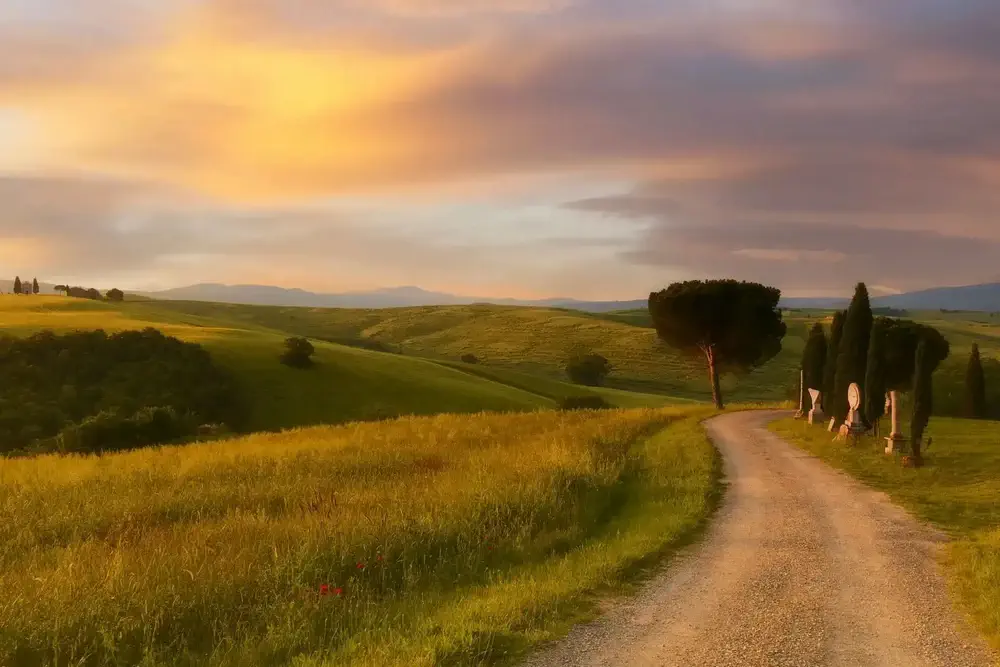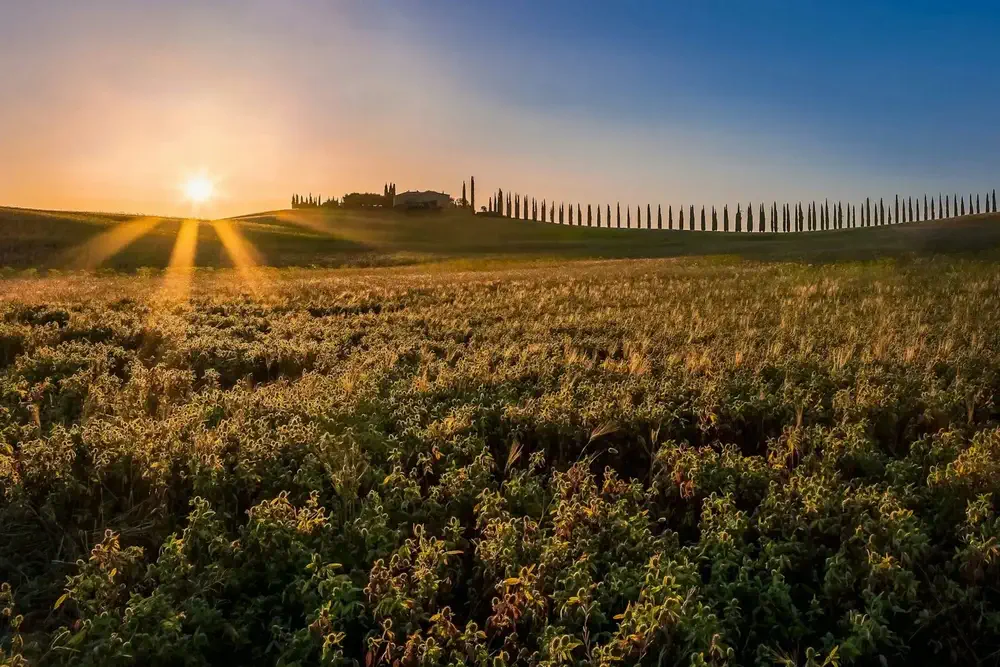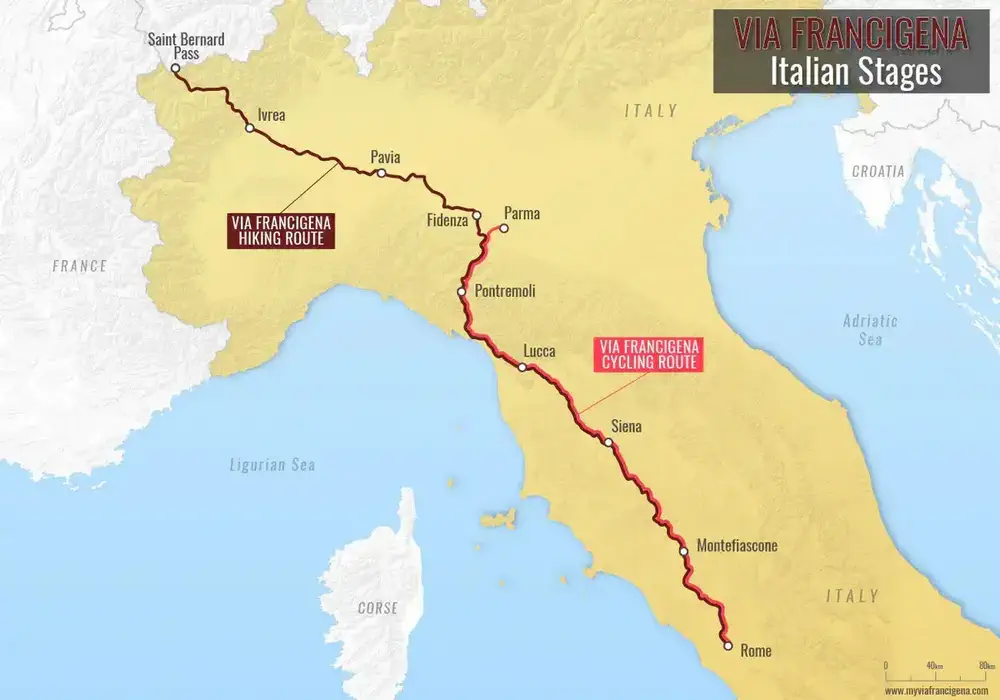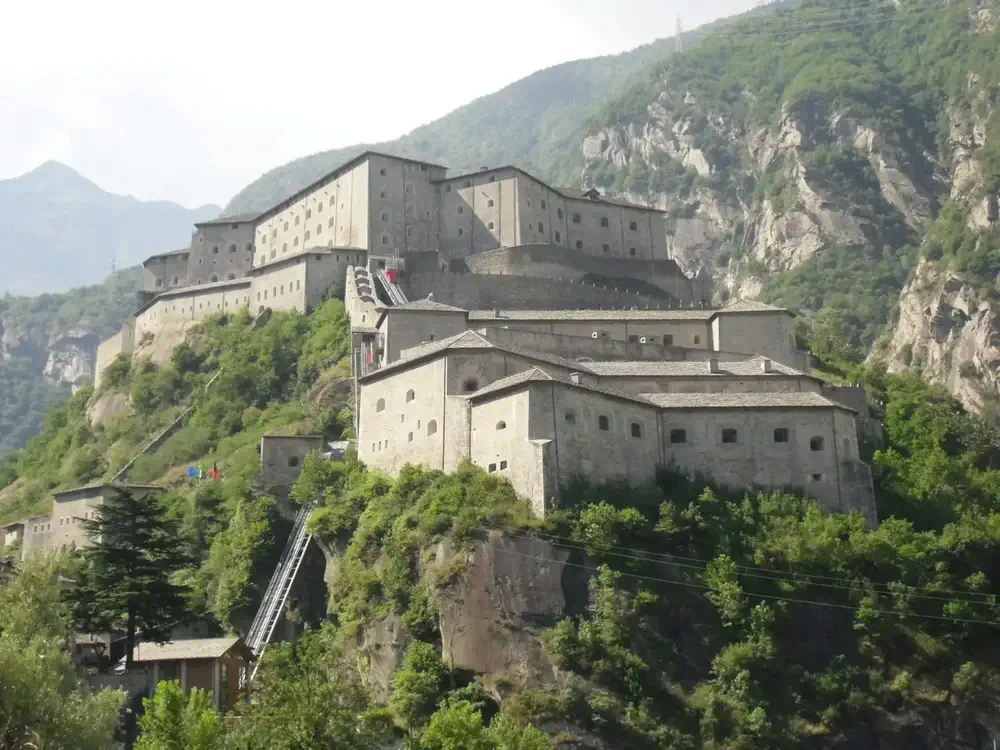Cycling the Via Francigena
Table of contents
Cycling the Via Francigena
Cycling the Via Francigena, also known as the “CicloVia Francigena”, is more than just a holiday—it’s an unforgettable adventure that immerses travellers in the beauty of Italy. From your very first pedal stroke on the trail to your triumphant arrival in the Eternal City of Rome, every site you visit, every meal you enjoy, and every interaction with locals offers a window into the charm and simplicity of Italian life.
While the full Via Francigena stretches from Canterbury, England to Rome, it’s the final portion winding through the Italian countryside that draws cyclists from around the world. With its rolling hills, picturesque vineyards, and charming villages, this route is perfect for those wanting to explore Italy on two wheels while experiencing la dolce vita – the sweet life.

Why People Cycle the Via Francigena
There are countless reasons why travellers choose the Via Francigena for a cycling adventure. At its heart, it’s a deeply personal experience that can be tailored to each rider’s interests and goals. Here are a few reasons why cycling the Via Francigena is such a popular choice:
1. An Active Way to Connect with History
Cycling the Via Francigena lets you retrace the footsteps of ancient pilgrims while enjoying the freedom and speed of a bike. You’ll pass through historic landmarks like the Aosta Valley, hilltop towns in Tuscany, and, of course, Rome. Along the way, you’ll encounter remnants of Italy’s fascinating past, from Roman ruins to medieval monasteries and renaissance-era architecture.
2. Scenic Routes Perfect for Cycling
The Via Francigena is known for its diversity of terrains, with rolling hills, flat stretches, and gentle climbs, making it ideal for cyclists of varying experience levels. From the vineyards of Tuscany to the rugged Apennine mountains, every turn offers spectacular views and well-maintained cycling paths. Plus, you can focus on the beauty around you knowing that your luggage will be taken care of thanks to services that handle transfers for you!
3. Culinary Experiences for Foodies on Two Wheels
Cycling isn’t just about the ride—it’s also about fuelling your adventure (and rewarding your efforts!). The Via Francigena takes you through regions famed for their food and wine. Indulge in authentic Tuscan pasta dishes, local delicacies like pecorino cheese and Proscuitto di Parma, and sip on regional wines—because every great ride deserves a memorable meal.
4. Community and Solitude on Your Terms
Cycling the Via Francigena provides the perfect balance of community and independence. Cycle alongside fellow enthusiasts who share your passion for adventure, strike up conversations with locals at charming cafes, or enjoy tranquil moments with nothing but the sound of your bike wheels on the road. Whether solo or in a group, the experience is uniquely yours.
5. A Sustainable and Rewarding Journey
There’s no better way to explore Italy sustainably than on two wheels. Minimize your carbon footprint as you cycle through breathtaking landscapes, and know that your trip directly supports local economies—helping the towns and regions flourish for future travellers.

Cycling Sections of the Via Francigena
Covering much of the same terrain as the walking route, the Via Francigena cyclepath offers travellers the chance to experience the same stunning views, diversity of landscapes, and regional differences in culture, albeit on a compressed timeline.
The Italian portion of the Via Francigena is often broken up into 3 sections for those looking to cycle the route, covering longer daily distances than pilgrims undertaking the walking route. Beginning at the Great Saint Bernard Pass, travellers will make their way through the Aosta Valley and across the Po River Valley to Parma, before traversing the second stretch across Tuscany from Parma to Siena. From there, the route departs Siena, leaving behind the Tuscan hills for Lazio on the approach to Rome.
It’s an incredible journey that highlights the beauty of Italy’s changing landscapes, the rich cultural traditions of its people, the impressive architecture of its buildings, and the savoury flavours of its food.
Here is an overview of the 3 Italian sections when cycling the Via Francigena:

Beginning in the San Bernardo Pass, the CicloVia Francigena mirrors the pilgrim footpath, traversing the stunning alpine landscape of the Aosta Valley on the way into Piedmont. From there, travellers will cycle through the Medieval towns and villages of the Po River Valley, before arriving in one of Italy’s food capitals, Emilia-Romagna, where they can indulge in local delicacies such as Prosciutto di Parma, culatello di Zibello, and the king of cheeses: Parmigiano Reggiano. This initial section of the Via Francigena truly highlights the culture and cuisine for which Italy is renowned.
Travelling from Emilia-Romagna and into the heart of Tuscany, this section of the Via Francigena is arguably the most iconic. After leaving behind the rugged terrain of the Apennine Mountains, pilgrims will make their way to the crystal waters of the Ligurian Coast, before passing through the historic villages and towns spread across the Tuscan countryside. Experience the beauty of Medieval and Renaissance towns like Lucca and San Gimignano with its impressive array of towers, before cycling through olive groves and vineyards on the way to the walled city of Siena. It’s an incredible journey highlighted by beautiful landscape views and fascinating cultural sites.
The final section of the Via Francigena cycling route will take travellers from the charming city of Siena to the winding streets of Rome, immersing them in local culture while exposing the beauty of the landscape leading into the Eternal City. From Siena, pilgrims will enjoy the rolling hills and vineyards of the Val d’Orcia, before entering Lazio to visit the serene shores of Lake Bolsena. The Via Francigena experience culminates with the ride into Rome, where travellers can marvel at the dazzling array of ancient Roman monuments, before arriving at St. Peter’s Square to complete the pilgrimage.
When to Cycle the Via Francigena
The best time to cycle the Via Francigena is during the spring (May to June) and autumn (September to October) months. Although these times represent the peak season for the trail, they also offer mild temperatures, fewer tourist crowds, and stunning natural scenery, with spring bringing blooming wildflowers and lush greenery, and autumn treating cyclists to golden vineyards and crisp, pleasant air.
Summer in Italy can be quite hot, especially along the final stages of the trail as you approach Rome, and winter, though quieter, can bring rain, snow, and shorter daylight hours. It should also be noted that the Great St. Bernard Pass is generally only open from early-June until September due to large amounts of snow that make it inaccessible for most of the year. The Cisa Pass can also experience a fair amount of snow during late autumn or early spring. Choosing the right season will ensure a more enjoyable journey along this historic pilgrimage route.

FAQ on Cycling the Via Francigena
As with any long-distance cycling route, the Via Francigena comes with its own collection of frequently asked questions by travellers. Here are the most common:
1. What type of bike is suitable for the Via Francigena?
The best types of bikes for cycling the Via Francigena are mountain bikes or gravel bikes with wide tires suitable for a variety of terrain types.
2. How hard is the Via Francigena?
The Via Francigena varies in difficulty depending on the section. Some parts are relatively flat and easy, such as the Po Valley in Italy, while others—such as the Alps and the Apennines—are more challenging with significant elevation gains. Daily distances and weather conditions also affect difficulty, making it a moderate to strenuous long-distance ride.
3. How long is the Via Francigena?
The full route from Canterbury, England, to Rome, Italy, spans approximately 2,000 km (1,200 miles). The Italian section alone, from the Great St. Bernard Pass to Rome, is about 1,000 km (620 miles).
4. Is signposting along the Via Francigena good?
Signposting has improved significantly throughout Italy, featuring a well-marked route with stickers or blue/white arrows labelled CicloVia Francigena. Even still, carrying a GPS device or a detailed guidebook is recommended.
5. What is the makeup of the Via Francigena cycle path?
The CicloVia Francigena includes paved secondary roads that only see little traffic, while avoiding rough, unmaintained dirt roads whenever possible. The route is roughly 70% asphalt and portions of the trail that are dirt mostly traverse gravel roads with a stable surface. When there are no other alternatives, brief sections of the trail do utilize roads with heavier traffic.
Why Choose the Via Francigena for Your Cycling Holiday?
Whether you’re a seasoned cyclist craving your next challenge or a casual rider seeking a holiday filled with purpose and beauty, the Via Francigena has something for everyone. It offers the best of Italy in one incredible experience—stunning landscapes, rich history, delicious food, and the rewarding feeling of conquering a legendary route.
From the quiet, cobbled streets of medieval towns to the wide-open vistas of the Italian countryside, there’s no better way to experience the authentic charm of central Italy than with the open-air freedom cycling provides.
